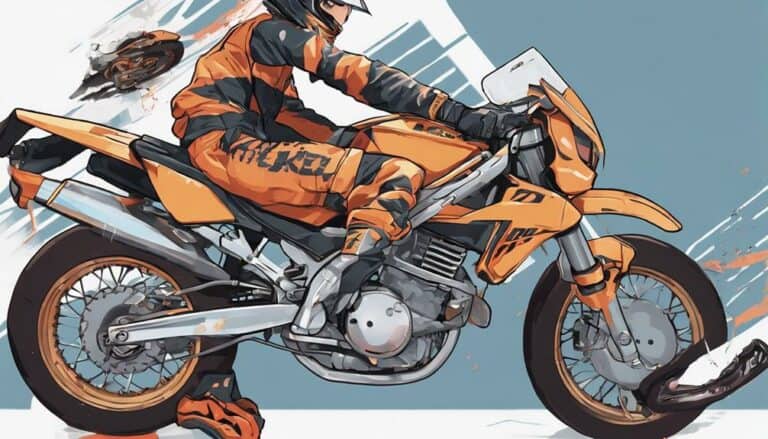When it comes to connecting your dirt bike's muffler to the head pipe, think of it as the essential link in a chain, ensuring your bike's performance remains excellent.
The process may seem intricate, but with the right guidance and tools, you can master this important task. From understanding the tools required to the final testing phase, each step plays an essential role in achieving a successful connection.
Stay tuned to discover the key steps in this process and how you can elevate your dirt bike's performance with a secure muffler to head pipe connection.
Key Takeaways
- Safely remove old muffler and inspect connection point for damage or debris.
- Align head pipe with exhaust port, install new grommets, and secure evenly.
- Properly align muffler, use provided hardware, and apply sealant for a leak-free connection.
- Tighten all bolts securely, visually inspect for gaps, and conduct a leak test for an airtight joint.
Tools Required for the Job
To effectively join the muffler to the head pipe on a dirt bike, you'll need an eight and ten-millimeter T-handle for bolting and unbolting, a spring puller for safely removing exhaust springs, safety glasses, rubber gloves, rags for cleanliness, and high-temp silicone or silicone lube for lubricating o-rings. These tools are essential for ensuring a secure connection between the components.
The eight and ten-millimeter T-handle allows you to easily tighten and loosen bolts, facilitating the assembly process. The spring puller plays an important role in safely detaching exhaust springs without causing damage. Safety glasses and rubber gloves are necessary to protect yourself from any debris or potential burns. Additionally, using rags helps maintain cleanliness throughout the procedure.
Lastly, applying high-temp silicone or silicone lube on the o-rings ensures a proper seal and prevents any leaks. Make sure to have all these tools ready before starting the connection process to make it smoother and more efficient.
Removing the Old Muffler
Start by locating and accessing the mounting bolts that connect the muffler to the head pipe on your dirt bike. To efficiently remove the old muffler, follow these steps:
- Carefully remove any securing clips or fasteners holding the muffler in place.
- Use appropriate tools like a socket wrench or pliers to loosen and detach the bolts or screws.
- Once the mounting hardware is removed, gently slide the old muffler off the head pipe.
- Inspect the connection point for any damage or debris that may need to be addressed before installing a new muffler.
- Make sure that the area is clean and free from any obstructions that could hinder the attachment of the new muffler.
Attaching the New Head Pipe
Connect the new head pipe to the exhaust port on the engine, making sure proper alignment for a secure fit. Make sure to use the provided rubber grommets and new o-rings to guarantee a tight connection. Before attaching the head pipe, apply high-temp silicone or silicone lube on the o-rings for a better seal. Secure the head pipe to the engine by tightening the mounting bolts evenly and securely. To verify the alignment and connection, inspect the head pipe to the engine junction to prevent leaks or performance issues.
| Steps to Attach the New Head Pipe |
|---|
| 1. Align the head pipe with the exhaust port. |
| 2. Install rubber grommets and new o-rings. |
| 3. Apply high-temp silicone or silicone lube. |
Following these steps guarantees a proper and secure attachment of the new head pipe to the engine. Remember to check for leaks or any loose connections after installation.
Connecting the Muffler to Head Pipe
For a secure and leak-free connection between the muffler and head pipe on your dirt bike, confirm the exhaust gasket is correctly positioned. When connecting the muffler to the head pipe, proper alignment is essential to prevent leaks and guarantee peak performance.
Follow these steps for a successful connection:
- Align the muffler and head pipe properly to avoid any leaks or misalignment issues.
- Use the provided hardware like bolts and nuts to secure the connection between the muffler and head pipe.
- Apply a small amount of high-temp silicone around the connection for a proper seal and to prevent any exhaust leaks.
- Double-check the tightness of the connection to ensure it's secure and properly sealed for peak performance.
Testing the Connection
To guarantee a secure connection between the muffler and head pipe on your dirt bike, the next step involves verifying the tightness and integrity of the joint. Make sure to tighten the bolts properly to the manufacturer's recommended specifications using a torque wrench for a secure seal. Below is a table outlining the process to test the connection effectively:
| Testing Steps | Description | Tools Required |
|---|---|---|
| 1. Tighten Bolts | Guarantee all bolts connecting the muffler and head pipe are securely fastened to prevent leaks. | Torque Wrench |
| 2. Check for Alignment | Verify that the muffler and head pipe are aligned properly to avoid performance issues. | Inspection Tool |
| 3. Apply Sealant | Use high-temp silicone sealant or gasket maker on the connection for an added layer of security. | Sealant |
| 4. Visual Inspection | Inspect the joint visually to confirm there are no gaps or misalignments that could compromise the seal. | Inspection Tool |
| 5. Leak Test | Conduct a leak test by applying soapy water on the joint and checking for bubbles to ensure an airtight connection. | Soapy Water |
Conclusion
So there you have it, folks. With the right tools and a bit of elbow grease, you can successfully join your muffler to the head pipe of your dirt bike.
Remember, attention to detail is key, and safety first! Now go out there and hit the trails with confidence, knowing that your exhaust system is securely installed and ready to boost your bike's performance.
Ride on, my friends!

